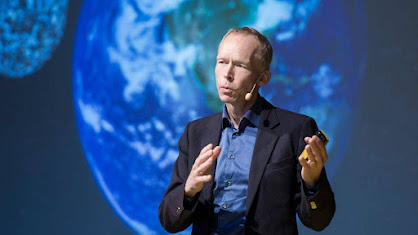Johan Rockström, a Swedish environmental scientist, has achieved much throughout his life but is most notably recognized for his leadership in the development of the planetary boundaries. His educational journey, which began at the Swedish University of Agricultural Sciences, where he focused on soil science and hydrology, laid the foundation for his expertise in global sustainability and water resources. After several years, he returned to school at Stockholm University to pursue his Ph.D. in Systems Ecology and Natural Resource Management. This academic background equipped him with the knowledge and skills to start his work in building stability and resilience in regions with water scarcity, primarily in tropical areas.
After two decades of focusing on water, Rockström switched to global sustainability. As mentioned earlier, he played a pivotal role in the formation of the nine planetary boundaries. Rockström led a team of 28 scientists who worked tirelessly to establish the boundaries and has since been the face of the new scientific thinking. Published in 2009, the boundaries consist of climate change, biodiversity loss, the biogeochemical cycle on Earth, ocean acidification, land use, freshwater availability, ozone depletion, atmospheric aerosol levels, and chemical pollution. Each area was identified as a regulator of the environment, consisting of a limit that, when crossed, would increase instability on the planet. According to Rockström, following the boundaries publication, only a few could be quantified, meaning establish the limit. He recalls that in their conception, they were intended to encourage further research and help best understand what needed to be done to return to optimal conditions. His work has not only influenced new thinking around achieving sustainability and mitigating climate change but has also significantly influenced the solutions put forth by governments. Importantly, all of the boundaries have been quantified, and it has recently been found that six have been crossed, underscoring the urgency and relevance of Rockström's work.
The discovery of the nine planetary boundaries can be understood as a creative process. In an interview, Rockström discusses how they narrowed it down to 9 boundaries. He reveals that there could be 50 or more indicators of environmental health, yet they narrowed it down, making it different from many other understandings of sustainability. He describes that narrowing down was not straightforward and required work in various Earth system science disciplines. He and his team collected information and scientific understandings, which helped them to find the boundaries. They used divergent thinking to challenge the norm of global sustainability. In doing so, they changed the domain of environmental science. In the same interview, Rockström elaborates on three significant scientific findings that helped establish the planetary boundaries. These findings include that Earth has entered a new geological epoch that humans drive, Earth’s regulating features have tipping points, and evidence showing that the environment's ability to support life diminishes when they are crossed. He describes these findings as leading them to ask what the regulating features are and how they can be quantified. Ultimately, Rockström and his team used the geneplore model to take in new information and then pose questions to help find more solutions to the climate crisis.
While discussing the planetary boundaries, Rockström uses an analogy to explain the creation. He provided the example of the sustainable development goals to help explain the goal of his research. The United Nations Sustainable Development Goals are commonly known and used by organizations and governments worldwide to guide development. Rockström similarly wanted the planetary boundaries to be a tool to measure the health of the environment, as well as to be the goal. By including this analogy, he explains the purpose of the boundaries to provide a map of the Earth’s optimal state.
As a creator, Rockström can best be understood through Rick Rubin's lens. Rubin explains the difference between an experimenter and a finisher in his book, The Creative Act: A Way of Being. An experimenter continuously adds to their work, often making it difficult to come to an end creation. A finisher has clarity and gets to their creation rather quickly. Of the two, I would argue that Rockström is more of an experimenter. While they first released the boundaries in 2009, Rockström and his team have continued expanding their knowledge about them. In 2015, they released updates on the boundaries. He describes the current state of the research as being in the review stage now, as it has become widely accepted, but he still claims the creation will continuously be worked on. Despite the ongoing nature of Rockström's research, I would also argue he has elements of a finisher. With significant findings, he shared the knowledge with the world; nothing was saved for the completion of the concept. This directly connects to Rubin’s point about the different kinds of creators. He believes that the best creatives are both experimenters and finishers. Subsequently, Rubin discusses the patience of creatives. He describes patience as something that is very difficult to achieve yet helps to enhance one's creativity. In the case of Rockström, the extended timeline and continued patience helped to elevate the creation of the planetary boundaries concept. Rockström describes how the boundaries were received with much skepticism and were often criticized. Instead of losing focus, Rockström and his team demonstrated remarkable perseverance in the face of skepticism, thus creating a product that would resonate later on.Lastly, Rubin describes regeneration, which is the ability of creation to inspire new creations in the future and create new understandings. Rockström’s work has developed new ideas related to understanding the climate crisis. His creation has inspired the future of his work and other environmental scientists. Currently, I am studying environmental studies, and I have engaged with Rockström’s creation in my classes. His work has greatly influenced me, allowing me to be part of the regeneration.
Sources:
https://www.youtube.com/watch?v=lLq8e73-FAw
https://news.mit.edu/2017/johan-Rockström-framework-for-preserving-earth-resilience-0926
https://www.speakersassociates.com/speaker/johan-Rockström/



No comments:
Post a Comment
Note: Only a member of this blog may post a comment.